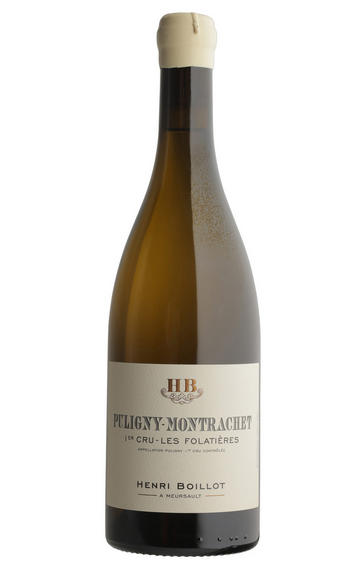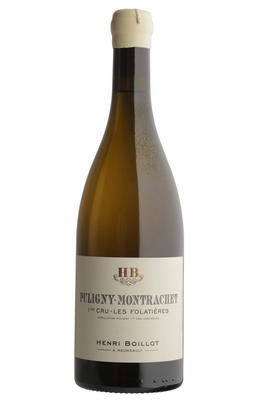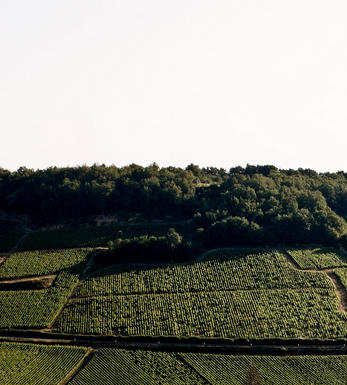
2020 Puligny-Montrachet, Les Folatières, 1er Cru, Henri Boillot, Burgundy

Critics reviews
Their pick from purchased grapes. Mid primrose colour, a sultry sunny nose, but detailed and attractive. Good tension on the palate but a bit blocky, banana and grenadine notes, so more exotic.
Certainly very intense here, though. The Folatières offers a different shape to the Meursaults, a fraction riper than my preference, but really long finish, very exciting in its style—and still a fresh finish.
Jasper Morris MW, InsideBurgundy.com (October 2021)
A slightly riper mix displays notes of various white orchard fruit, citrus confit and a vague whiff of the exotic, especially dried apricot.
The rich, caressing and generously proportioned flavours possess outstanding punch while delivering seriously good length on the clean, dry, youthfully austere finale.
This lovely effort should be approachable after only 3 to 4 years of cellaring.
Drink from 2028 onward
Allen Meadows, Burghound.com (June 2022)
The wine has a bright nose of green apple, with an edge of acacia flower and a suggestion of honey. The texture is dense and substantial, but far from being heavy, the wine is opulent yet deftly balanced.
Produced from purchased fruit that was crushed lightly before pressing and run into cask (50% new), with a good proportion of lees for fermentation and ageing.
Drink 2025 - 2040
Charles Curtis MW, Decanter.com (November 2021)
About this WINE

Henri Boillot
Henri Boillot has in a very short space of time build an extraordinary reputation for the sheer quality of his Burgundy wines. To call the the Henri Boillot label a mini-negoce does the wines a great disservice as, although Henri does not own the vineyards from which the grapes are sourced, he farms them as meticulously as if they were is own.
They are only ‘mini’ perhaps in the tiny levels of wine produced from each appellation. The meticulous and elegant Henri Boillot also owns and manages the Domaine founded by his grandfather. The sheer quality of these wines, including the impressive and exclusive Les Mouchères monopole, is testimony to the assiduous work he has done in both the vineyards and cellar.
Herni's wines inlcude several Premier Crus from Meursault (Les Poruzots, Les Charmes, Les Genevrières, Les Perrières), Puligny Montrachet (les Folatières, les Perrières, les Pucelles, les Mouchères), Chassagne-Montrachet (Chevenottes, Embrazees), Volnay and Savigny-les-Beaune.

Puligny-Montrachet
Puligny was one of two villages (along with Chassagne) which gained permission in 1879 to hyphenate the name of its most famous vineyard, Montrachet, to its own.
The reputation of Puligny-Montrachet is based around its four Grands Crus. Montrachet labels often boast a noble, triumphant 'Le' in front of its name, lest you dare confuse it with any lesser wine. It has much to be proud of, with many considering Montrachet to be the greatest white wine in the world. At its best it has an intensity, complexity and elegance that make you wonder how such a wine could be made from mere grapes.
The luxurious and explosive Chevalier-Montrachet is not quite as deep, although it is probably the next best. Only marginally less impressive, and rather more consistent than Montrachet is the richly textured Bâtard-Montrachet (also shared with Chassagne). Bienvenues-Bâtard-Montrachet is equally good, with the focus on honeyed finesse and exquisite balance rather than richness.
These legendary wines are supported by a host of fabulous Premier Cru vineyards capable of reaching Grand Cru quality. Brimming with flavour and intensity, Le Cailleret and Les Pucelles (which both lie across the road from Le Montrachet) are prime candidates, along with Les Demoiselles, Les Combettes and Folatières.
Sandwiched between the larger Chassagne and Meursault, Puligny produces wines that are more striking than any in the Côte d’Or, portraying a floral elegance alongside a stylish, steely concentration. They are very different to Meursault: more refined and delicate, and less rich.
Village level Puligny-Montrachet from top growers can be very good indeed, but is all too often unexciting and disappointing. Grands Crus normally need at least eight years before they can be broached, and last for 20 or more. Premiers Crus should generally be enjoyed between five and 15 years of age; village wines from three to 10 years.
In theory, you can find red Puligny-Montrachet, but it scarcely exists anymore, and is rarely worth the price tag.

Chardonnay
Chardonnay is often seen as the king of white wine grapes and one of the most widely planted in the world It is suited to a wide variety of soils, though it excels in soils with a high limestone content as found in Champagne, Chablis, and the Côte D`Or.
Burgundy is Chardonnay's spiritual home and the best White Burgundies are dry, rich, honeyed wines with marvellous poise, elegance and balance. They are unquestionably the finest dry white wines in the world. Chardonnay plays a crucial role in the Champagne blend, providing structure and finesse, and is the sole grape in Blanc de Blancs.
It is quantitatively important in California and Australia, is widely planted in Chile and South Africa, and is the second most widely planted grape in New Zealand. In warm climates Chardonnay has a tendency to develop very high sugar levels during the final stages of ripening and this can occur at the expense of acidity. Late picking is a common problem and can result in blowsy and flabby wines that lack structure and definition.
Recently in the New World, we have seen a move towards more elegant, better- balanced and less oak-driven Chardonnays, and this is to be welcomed.


Buying options
Add to wishlist
Description
Their pick from purchased grapes. Mid primrose colour, a sultry sunny nose, but detailed and attractive. Good tension on the palate but a bit blocky, banana and grenadine notes, so more exotic.
Certainly very intense here, though. The Folatières offers a different shape to the Meursaults, a fraction riper than my preference, but really long finish, very exciting in its style—and still a fresh finish.
Jasper Morris MW, InsideBurgundy.com (October 2021)
wine at a glance
Delivery and quality guarantee